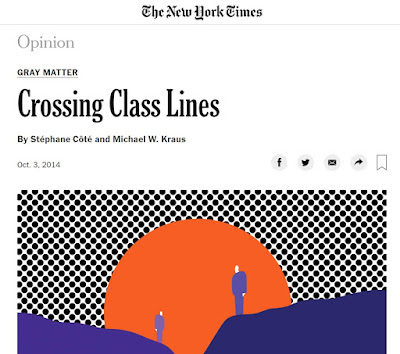I like this YouTube channel so much I am including another video that only tangentially related to this topic. It is a great reminder that many of our choices are half chance and you shouldn't be too hard on yourself when you make a mistake. Do people of different classes have varying attitudes toward this? Are they taught to think different things about mistakes from a young age?
“An old joke has an Oxford professor meeting an American former graduate student and asking him what he's working on these days. 'My thesis is on the survival of the class system in the United States.' 'Oh really, that's interesting: one didn't think there was a class system in the United States.' 'Nobody does. That's how it survives.” ― Christopher Hitchens, Hitch 22: A Memoir
Thursday, September 26, 2019
Status Anxiety
I like this YouTube channel so much I am including another video that only tangentially related to this topic. It is a great reminder that many of our choices are half chance and you shouldn't be too hard on yourself when you make a mistake. Do people of different classes have varying attitudes toward this? Are they taught to think different things about mistakes from a young age?
Tuesday, September 24, 2019
Monday, September 23, 2019
Social Class in America (1957)
Social Class in America (1957)
This 1950's educational video is surprisingly relevant to the structure of the social class system today.
Crash Course Sociology
Social Stratification: Crash Course Sociology #21
Why is there Social Stratification?: Crash Course Sociology #22
Social Stratification in the US: Crash Course Sociology #23
Social Class & Poverty in the US: Crash Course Sociology #24
The Impacts of Social Class: Crash Course Sociology #25
Social Mobility: Crash Course Sociology #26
These Crash Course Sociology videos (Numbers 21-26 of the series) are a superb resource for students learning about social class in the United States.
The New York Times: Crossing Class Lines
Crossing Class Lines (Click to open)


This is an interesting article about how focusing on shared characteristics promotes cross-class interaction.
People Like Us - Social Class in America
I chose this PBS documentary as a starting point in my exploration of social class.
People Like Us (1999)
This documentary examines class in American society. The content is strikingly relevant to the discussions on social class that are still ongoing even though the film is now twenty years old.
As the thesis of the film asks, "It's the 800-pound gorilla in American life that most Americans don't think about: how do income, family background, education, attitudes, aspirations, and even appearance mark someone as a member of a particular social class?"
Within the first ten minutes of this two-hour film, the audience is faced with the stark reality of the American social class system and the vast disparity between the "haves" and the "have nots."
People on the street and in shopping malls are asked to look at photographs of people and rate the perceived class of the subjects. Later, other respondents are asked which class they identify with and the overwhelming majority choose the middle class. This is really no surprise since most Americans feel that they live a middle-class lifestyle and haven't examined the data about where their place is along the income curve.
Income is what most consider the main determinant of class in America. However, there are many other factors that determine what class you are part of. As discussed in the film, the amount of white bread that you consume is an indicator of which class you are part of. On average, people who consume more white bread are at the lower end of the class spectrum.
This film examines people at both the top and bottom of American society as well as the working class and the middle class.
People Like Us (1999)
This documentary examines class in American society. The content is strikingly relevant to the discussions on social class that are still ongoing even though the film is now twenty years old.
As the thesis of the film asks, "It's the 800-pound gorilla in American life that most Americans don't think about: how do income, family background, education, attitudes, aspirations, and even appearance mark someone as a member of a particular social class?"
Within the first ten minutes of this two-hour film, the audience is faced with the stark reality of the American social class system and the vast disparity between the "haves" and the "have nots."
People on the street and in shopping malls are asked to look at photographs of people and rate the perceived class of the subjects. Later, other respondents are asked which class they identify with and the overwhelming majority choose the middle class. This is really no surprise since most Americans feel that they live a middle-class lifestyle and haven't examined the data about where their place is along the income curve.
Income is what most consider the main determinant of class in America. However, there are many other factors that determine what class you are part of. As discussed in the film, the amount of white bread that you consume is an indicator of which class you are part of. On average, people who consume more white bread are at the lower end of the class spectrum.
This film examines people at both the top and bottom of American society as well as the working class and the middle class.
Subscribe to:
Comments (Atom)
